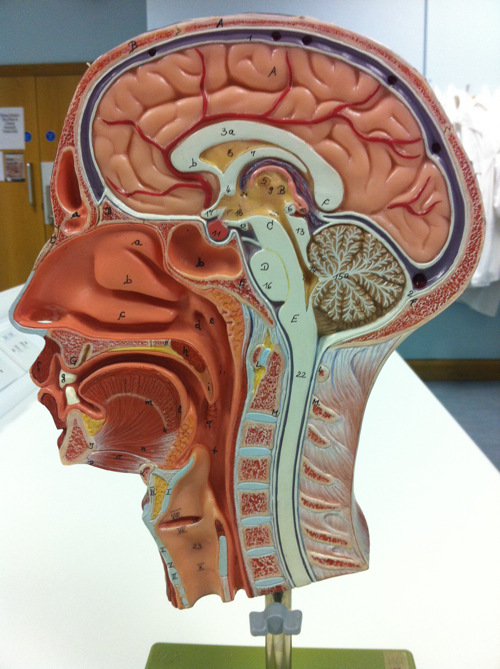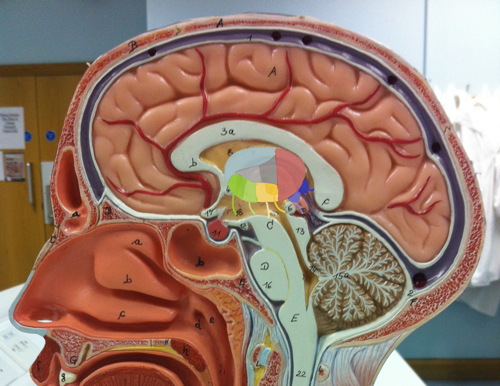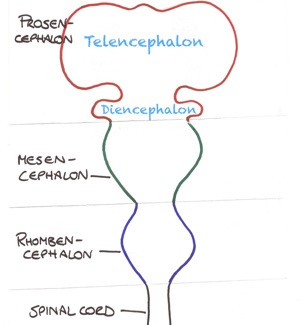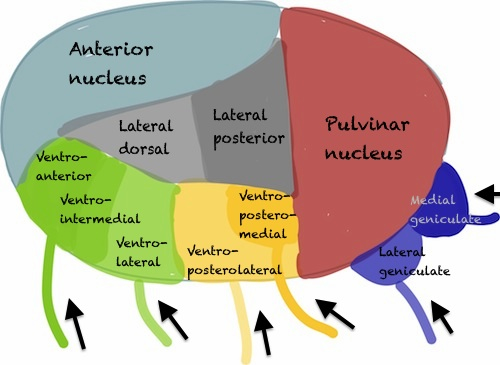
I’m finally reaching a stage in my life where neuroanatomy is becoming interesting. I know – it’s hard to believe. I really, really struggled when I first encountered the brain 20 years ago, I’ve really struggled since, and after teaching anatomy for almost a decade (next year will be my 10th year at Swansea University in my current role) I seem to be not only getting to grips with it, but to be becoming fascinated by it.
Part of this is having some time to read about it. You have to learn it twice to teach it once. I’m very much a novice, and I only have to bite off little chunks at a time. Like the medicine course at Swansea I’m then linking those chunks up over time to develop a slightly better understanding of what’s going on in terms of neuroanatomy. Neuroscience is still something of a black box of magic, even with the podcasts.
So, what about the thalamus?
This week we talked about the anatomy of the thalamus and linked it up to our discussions a few weeks ago about spinal tracts, and how all (almost all?) of the sensory neurones of the spinal cord send axons up to the thalamus for “processing” before any information is passed onwards to our sensory cortex bits at which point we become (often) consciously aware of that sensory input. E.g. “ow!”
If we look at the thalamus, we find collections of nuclei arranged in the shape of a small egg found surrounded by the cerebrum. The thalamus is not a single structure, but a paired structure either side of the third ventricle, and each of those structures is really a collection of nuclei with tracts and bundles of neurones running in and out. The anatomy here is showing us the functions of the thalamus.

The location is important, and not just for medical students recognising it when I put a pin in it. The thalamus formed from the diencephalon, and the cerebrum formed from the telencephalon. The telencephalon was the most bulbous part of the rostral end of the ballooning neural tube during development, and the diencephalon was the swelling just caudal to that. As the brain develops the cerebrum and cerebellum come to surround the thalamus. The thalamus has significant connections to them, so it’s sensible that it lies in the middle.

We talked about the functions of the thalamus as we understand them at this stage of the course. When we looked at the spinal tracts we talked about how the sensory tracts all pass to the thalamus before being relayed to the cortex if appropriate. The spinothalamic tract clearly runs from the spinal cord to the thalamus. Tracts of the dorsal column also run to the thalamus. Remember that all of this sensory information has crossed to the opposite side of he body by the time they reach the thalamus.
So we’ve seen a lot of sensory wiring carrying information into the thalamus. That’s a huge amount of information coming into a small part of the brain. Consider all of the sensation from all of your skin: pain, temperature, fine touch, coarse touch. Your skin is detecting a huge amount of sensations all the time, yet most of the time you don’t notice. When a tiny fly lands on your arm you’re instantly aware of that change, but you didn’t notice the breeze blowing across it moments before. You probably didn’t notice how the ball of your left foot felt until I mentioned it. How does all that work?
I sometimes think of the thalamus as a sensory filter. Stuff that isn’t important isn’t passed on to the cerebrum, so isn’t passed on to the consciousness’ awareness. You don’t notice it. But stuff that is important (the fly – is it going to sting or bite?) is passed on, and your awareness reacts and looks for the fly. So the thalamus dampens the inputs of some neurones and reinforces others.
Structurally, neurones of the spinothalamic tracts and the medial lemniscus pass into a particular nucleus with the thalamus called the VPL. I’m not very good with acronyms and this triggers the term, “visible panty line” in my own brain, which isn’t particularly helpful other than for remembering the acronym. The VPL in the thalamus is the ventroposterolateral nucleus, so named because it is lateral to the ventroposteromedial nucleus. Helpful? Probably not, but bear in mind that the thalamus is actually a collection of nuclei, each named by its relative location to all the others (i.e. anterior, posterior, lateral, medial).

By “nuclei” I mean a collection of neurone cell bodies within the central nervous system. These are cell bodies of neurones that are synapsing (connecting) with other neurones, so these are also areas of connections and of potentially massive complexity. Nuclei within the central nervous system are equivalent to ganglia in the peripheral nervous system.
The VPL is receiving somatosensory information from the opposite side of the body, which it then discards or passes on to the level of awareness. The VPM (ventroposteromedial) nucleus receives somatosensory information from the contralateral face, as neurones from the trigeminal nerve (trigeminothalamic tract) enter here. It also receives taste information. If appropriate it also passes on this sensory information to the primary sensory cortex.
You’ve probably heard of the lateral geniculate nucleus from your eye anatomy & function studies. The lateral geniculate nucleus receives information from the retina via the optic tract (you may want to have another look at visual fields to add to this) and passes information on to the pulvinar (a big posterior nucleus within the thalamus) and on to the visual association cortex and the primary visual cortex. Again you’re not aware of everything you “see”. There are ideas of perception as an illusion, with your brain processing huge amounts of visual information and only passing the relevant stuff to the consciousness’ awareness. When something moves fast or unexpectedly in the “corner of your eye” you’re instantly alerted to this. Much of this processing is probably going on in the thalamus.
Interestingly the cerebellum is also well linked with the thalamus. Using the example of vision, when you read this sentence your eyes are not smoothly moving across the line. They’re darting back and forth and your brain is compiling the words into a sentence that you “read”. Similarly when you look at someone’s face your eyes dart between their eyes, mouth, nose, hairline and other features, building up an image of their face. This is known as saccadic movement, and is controlled by the cerebellum. These links between the optic nerve, thalamus, cerebellum, ocular muscles and the cerebrum are all relevant to this.

If there’s a lateral geniculate nucleus then there will be a medial geniculate nucleus, and this guy receives auditory input from the cochlear part of the vestibulocochlear nerve via the inferior colliculus (literally a “little hill” that is a key part of the auditory pathway). Hearing information comes into the thalamus here, is also passed onto the auditory cortex.
Those are all the sensory nuclei of the thalamus, and the posterior and inferior parts of the thalamus. The thalamus also has motor components.
In the ventral half of the thalamus, inferiorly there are 3 main motor nuclei: the ventroanterior, ventrolateral and ventrointermedial nuclei. The cerebellum (the part of the brain that helps us co-ordinate complex movements) sends neuronal fibres into the ventrolateral and ventrointermedial nuclei. The basal ganglia (the part of the brain that has been described as being involved in choosing an action, and is linked to movement and procedural learning) sends information into the ventrolateral and ventroanterior nuclei. Linking sensory inputs to motor outputs seems to be a role of the thalamus.
The last few nuclei within the thalamus, the anterior, mediodorsal and centromedian nuclei (that last one is hidden in the middle) are linked to the limbic system. This part of the brain is shrouded in some mystery to me, but its often summarised as a collection of nuclei and parts of the brain that are involved in emotion, learning, drive and motivation. These structures are really close to the thalamus. The best known part of the limbic system (I think) is the hippocampus, which is well known for its role in memory.
The limbic system therefore is also wired up to the thalamus, and damage to (or pathology of) the thalamus affecting those parts have been seen to affect drive. See also “The cortico-basal ganglia integrative network: the role of the thalamus” by Haber & Calzavara. Give me a few more years and I might start to understand some of this.
Given the connections of the thalamus to other parts of the brain and body, I hope you now see that the thalamus is a very important structure for normal function, and that it is somewhat heterogenous. Remember that all of its connections have not been found, and its complete range of functions are not understood. You can probably imagine the range of symptoms damage to different parts of the thalamus can cause. I’ll leave that to your imaginations and to your Google searches, and will avoid going into any more detail here.
Comments
2 responses to “The Thalamus”
Great article.
Really helpful, thank you!